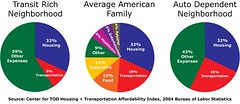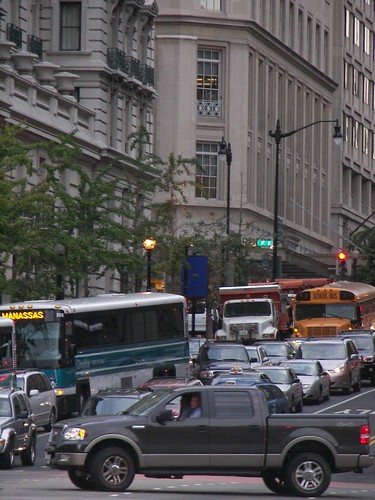Transportation planning in the District of Columbia

Today's Post has a front page story, "Drivers Feeling Shunned by D.C.," on how DC is reorienting transportation policy "against commuters" and "against driving."
It is a delicate balance, to encourage more optimal mobility choices in part by making driving less convenient, and at the same to maintain the District's economic competitiveness overall and as an attractive place to locate "business." (A lot of business here is "white collar" -- associations, law firms, lobbying organizations, etc.)
It's also about local economic development and building household income and wealth.

Household budget weighted according to transportation mode dependence and access.
Also see the blog entry "Transit and DC's prosperity."
I have some problems with some of the City's initiatives (I'm fine with changing traffic patterns, improving streetscapes, and focusing on pedestrian-walkability improvements), in part because I have a bias that favors comprehensiveness.
I am also troubled that a number of these initiatives come from the City Council, rather than from "a plan." Another is that for the most part, these initiatives focus on nonresidents, while giving residents--all those SUV owners, households with multiple cars, with access to virtually free street parking--a pass, which encourages "suboptimal" transportation decision making at the household level.
DC doesn't as yet have a master transportation plan (cf the Arlington County Master Transportation Plan), although a plan is being created although there have been no public meetings as of yet. There is the Transportation Element in DC's 2006 Revised Comprehensive (Land Use) Plan, which is the closest to a transportation plan as of yet. But one of the problems with this Element is that it isn't ordered within--it doesn't adequately set priorities.

And the Comprehensive Plan was a missed opportunity to address transportation demand management more generally as well as parking and curbside management. (Also read the Arlington County element to understand this.)
-- Parking and Curbside Management blog entry
Arlington's plan is very clearly focused on promoting optimal mobility. Optimal mobility, especially in urban areas, is not centered around automobility. Arlington focuses on overall mobility, rather than pitting residents vs. non-residents in terms of how policies, goals, and objectives and conceptualized, developed, and implemented. Car use is discouraged generally. Residential car usage is not privileged, as it is in DC. (Although Arlington is the place that pioneered residential parking permit policies, which required a ruling by the U.S. Supreme Court to affirm.)
Fortunately, DC benefits from the L'Enfant Plan which in the core of the city yielded a pedestrian centric urban design, with a dense network of streets in a grid street pattern, augmented by radial avenues, and the location of housing relatively close to work and other destinations.
DC's land use "plan" was created during the Walking and Transit City eras -- 1800 to 1920. By contrast, this is something that other jurisdictions must create afresh, as indicated by two pieces in yesterday's Post, "Where the Car Is King, Tysons Faces a Dilemma: Urban Planners Take Aim at Free Parking" and Roger Lewis' column "A Realization in Fairfax About Traffic and Housing" (not to mention the Lewis column from two weeks ago, "Lessons of Arlington's Urban Development Needn't Be Just History").

So even though DC doesn't have anywhere near the kind of TDM policies and tools possessed by Arlington County, DC has 50% better mode shift (people using transit, or walking and biking) than Arlington County. DC's mode shift is the second best of any major U.S. city.
(And just think how much better it could be if DC really tried.)
DC is unusual politically in that unlike other places, it isn't reliant on state enabling legislation to define what local jurisdictions can or can't do. Arlington County cannot impose transportation demand management policies, instead it provides multiple carrots to encourage it, and in some instances allowable development densities are dependent on TDM plans.
Contrast this to DC. While the redevelopment of Potomac Yards in Arlington and Alexandria is linked with TDM planning, redevelopment planning for the Armed Forces Retirement Home is completely disconnected from TDM planning. Whereas dedicated bus lanes (with the ability to convert to streetcars) are being constructed within Potomac Yards, there is no discussion of how development at AFRH, combined with the Washington Hospital Center, as well as plans at the McMillan Reservoir, should be paired with transit expansion, in order for the project to go forward.
It's easy for City Council to direct efforts "against" nonresidents, but it takes guts to step up and deal with residents. Maybe this is a process and that is the next step, but it's difficult, and there is tremendous pushback on the part of residents, especially those who see automobile-centric living as natural as breathing. Plus, because the city doesn't have a transportation plan and overarching priorities, it's difficult to lay out "citywide" objectives vis-a-vis neighborhood preferences and biases.
This comes up all the time in neighborhood planning processes, whether or not the processes are conducted by the DC Department of Transportation, see Transportation Studies for examples, or the DC Office of Planning, see Neighborhood and Revitalization Plans for examples. (DCOP and DDOT work together on planning. OP's land use plans involve transportation and streetscape matters, while DDOT's studies focus on transportation and streetscape specifically.)
If I had $1 for every time I've heard people recommend that we build parking structures in neighborhoods for residents, using Bethesda and Silver Spring as examples, I'd be rich. Note that these parking structures are built to support the commercial districts, and don't provide residential parking.
One of the damning aspects of today's Post article is that there is no discussion of expanding the transit infrastructure. (Although that wasn't the focus of the article.)
In January and February I produced what I called the "The revised revised People's Transportation Plan/2008 Transit-Transportation wish list," which after modifications is an extremely long document that frankly, could suffice as the goals section of a DC Master Transportation Plan. But there are more than 30 points. Here's what I think should be the absolute priorities in terms of broad policy:
1. Creating a "transit first" transportation policy for the District of Columbia. San Francisco has enshrined such a policy in their City Charter. Would that DC do so as well.
-- See the discussion on a transit first policy within this blog entry:
Comprehensive planning vs. piecemeal legislation: the difference between NYC and DC
2. Linking land use and transportation planning by mandating "accessibility planning." This form of planning rates uses by the amount of transportation demand generated, and places by the capacity of the transportation network, and links uses to places according to the ability to meet transportation demand optimally.
See "Utrecht: 'ABC' Planning as a planning instrument in urban transport policy."
3. Create a DC transportation plan. Use Arlington's as a model. Set optimal transportation and mobility as the priority rather than treating all modes as equal. Sure the DC Department of Transportation is responsible for managing all transportation modes, but optimal mobility must be the priority.
4. Pair transportation demand management planning and programs with accessibility (land, use, and transportation) planning.
What this means instead of DC City Council writing all kinds of wacky legislation from tolling the 14th Street bridge to wanting to charge a tax of $25/month for office parking (which wouldn't be able to be assessed against federal government owned and probably leased spaces, which is a big problem, see the big parking lots by the Senate and House office buildings), and giving churches a free pass on Sunday parking, etc., that master goals and objectives would lead policy.
E.g., it's fine to change the traffic patterns for commuter routes. But at the same time, if the city wants to be effective, institute HOV-2 requirements on commuter streets during rush hour. That's just one eensy weensy policy that would flow from a comprehensive approach.
5. Work to get a transit withholding tax assessed on all people working within DC. This isn't a commuter tax but is just as hard to enact. Certain Oregon counties assess such a tax, which is assessed on employers. All the monies received should be spent on transportation infrastructure and service improvements.
This is discussed in more depth and various uses for these monies are outlined in the People's Transportation Plan and would include:
• a separated blue line subway line in the core of the city, providing an additional Potomac River crossing in Arlington as well as more capacity and redundancy within the core of the city, where the subway lines are projected to reach maximum capacity over the course of the next decade;
• (re)creating a streetcar network in DC;
• bus service enhancements; and
• the creation of an intra-neighborhood bus service system that would likely provide service free of charge.
Remember that with WMATA cutbacks in 2003, primary responsibility for transportation infrastructure planning and development devolved to the individual jurisdictions. Even though it makes no sense!
This means that DC is responsible for initiating transportation capacity increases within DC, recognizing that while meeting residential needs, regional transportation objectives are at least as and in some dimensions more important.
Meanwhile the streetcar planning is sputtering. In the meantime Arlington and Fairfax are moving into the design and engineering phase for the Columbia Pike streetcar line. And Maryland's MTA is pushing ahead on the Purple Line light rail line for Montgomery and Prince George's Counties.
It's time to focus on the big picture.
See the blog entries:
-- Thinking about the transit network
-- The (Meta) Regional Transit Network and transportation "vision" maps
-- I'm embarrassed (discusses polycentric and monocentric transportation systems in the Washington region).
Labels: neighborhood-based transportation planning, sustainable land use and resource planning



0 Comments:
Post a Comment
<< Home